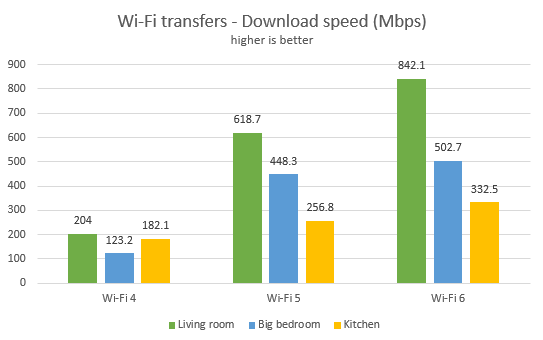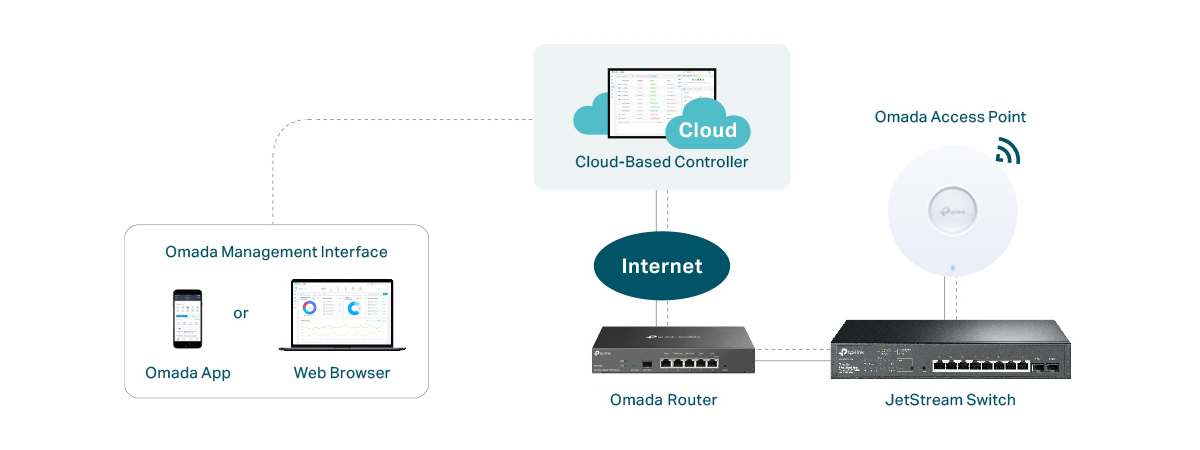
All router manufacturers have migrated towards the Wi-Fi 6 standard, and the market is filled with new routers that list Wi-Fi 6 support as their main feature. If you want to upgrade your home network, both TP-Link and other manufacturers recommend buying a router with Wi-Fi 6. The reason is these models tend to offer higher speeds and new hardware that can better handle a home network with an ever-increasing number of devices. This sounds great in theory, but how are things in real life? What speed advantages do you get when buying a TP-Link router with Wi-Fi 6? Read our analysis and find out:
The testing procedure and the TP-Link routers we used
Wi-Fi 6 is a new standard for wireless networks that includes many innovative technologies which allow it to offer faster networks, a wider coverage area, and the management of a higher number of connected devices. Also, routers with Wi-Fi 6 can offer increased security through WPA3 - a new encryption standard that is available only on routers with Wi-Fi 6, as well as less power consumption. To make our analysis about Wi-Fi 6 as relevant as possible for most home users, we took two TP-Link routers with support for this standard:
- TP-Link Archer AX10 - TP-Link’s Wi-Fi 6 router with the most accessible price, so many people can afford to buy it. In our review, we rated it as one of the best budget models on the market. Archer AX10 is a dual-band router with solid hardware (three-core Broadcom processor, 256 MB of RAM), which offers access to Wi-F 6 only on the 5 GHz band. On the 2.4 GHz band, this router can use the Wi-Fi 4 (802.11n) standard, not Wi-Fi 6.
- TP-Link Archer AX50 - costs a little more, but it offers access to Wi-Fi 6 on both its bands: 2.4 GHz and 5 GHz. Another important feature is its more advanced firmware, which includes useful features such as cloud-based antivirus and parental controls, a USB 3.0 port, and an Intel processor with two-cores instead of a Broadcom processor.
Both routers are reasonably priced and don’t represent expensive purchases. It would have been easy for us to ask TP-Link to send a costly model like Archer AX6000 and show how a premium router can outperform older routers that use the older standards. However, would that have been realistic and useful to you and other users who are going to buy only reasonably priced routers?
Because we don’t want our analysis to be too long and tedious, we decided to make the same sets of measurements on both routers in the following three rooms from our test apartment, which has a footprint of approximately 80 square meters or 861 square feet:
- Living room - the room where the router is placed and where it is easy to reach the maximum speed each router is capable of.
- Big bedroom - a room separated from the router by one wall that reduces both the signal strength and the speed. In any apartment, no matter how carefully you place a router, most rooms are going to be separated from the router by one wall. This is why, for the majority of people, the measurements made in this room are going to be the most relevant for a router’s real-life performance.
- Kitchen - this room is relatively far from the router, situated at an angle that is a bit difficult to cover by all routers. In this room, most wireless routers that we test have issues with both the signal strength and the maximum speed that they deliver. This room helps you figure out how a router tends to perform in an area where it is challenging to provide solid signal strength.

The apartament and the rooms where we made our measurements
The tests we used to compare the speeds you get when using Wi-Fi 6 vs. Wi-Fi 5 vs. Wi-Fi 4 are the following:
- SpeedTest - tells us the maximum speed you can achieve when you browse or download content from the internet through the wireless network managed by your router.
- PassMark Performance test - tells us the average speed you get when transferring data through your network. It is relevant when you want to copy files from one device to another inside your network or when streaming media between your network devices. For Netflix or HBO Go, SpeedTest is more reliable than the PassMark Performance test.
Enough intro, let’s see the results we had:
TP-Link Archer AX10: Wi-Fi 6 vs. Wi-Fi 5 vs. Wi-Fi 4
The first router that we tested in our analysis is TP-Link Archer AX10 - an excellent choice for people with a modest budget. First, let’s see that maximum download speed achieved with SpeedTest in all three rooms, using the three standards:
- Wi-Fi 4 on the 2.4 GHz band
- Wi-Fi 5 and Wi-Fi 6 on the 5 GHz band
As you can see below, in the Living room, where it is easy to achieve the maximum speed available for each wireless standard, Wi-Fi 6 was the winner by a large margin. We measured a top download speed of 720.76 Mbps (absolutely excellent even for demanding users): it was 16.2% higher than the maximum speed reached with Wi-Fi 5 and 237% higher than Wi-Fi 4. In the Kitchen, where all routers have a “hard time,” the Wi-Fi 6 standard offered a download speed that was 20% higher than Wi-Fi 5 and 287% higher than Wi-Fi 4.

TP-Link Archer AX10 - Download speed in SpeedTest
Let’s see the comparison for the upload speed, that’s useful when you want to upload files over the internet. Wi-Fi 6 offered better speeds than the other standards in all rooms but the Kitchen.

TP-Link Archer AX10 - Upload speed in SpeedTest
PassMark Performance test tells us the average speed for network transfers. Here, the differences in favor of Wi-Fi 6 were even more significant. For example, Wi-Fi 6 was 36% faster in the Living room than Wi-Fi 5 and 312% faster than Wi-Fi 4. In the Kitchen, the room with the weakest signal, Wi-Fi 6 was 29% faster than Wi-Fi 5 and 82% faster than Wi-Fi 4.

TP-Link Archer AX10 - Download speed on Wi-Fi
When we measured the upload speed, Wi-Fi 6 remained the speed champion in all rooms.

TP-Link Archer AX10 - Upload speed on Wi-Fi
Our comparison shows that Wi-Fi 6 offers significant speed improvements, even when buying a more affordable router, like TP-Link Archer AX10. There’s no need to invest a lot of money to benefit from Wi-Fi 6 and what it has to offer.
TP-Link Archer AX50: Wi-Fi 6 vs. Wi-Fi 5 and Wi-Fi 6 vs. Wi-Fi 4
TP-Link Archer AX50 is a model that can use Wi-Fi 6 on both bands: 2.4 GHz and 5 GHz. On this router, we made the same tests as earlier, but we grouped them differently: Wi-Fi 6 vs. Wi-Fi 4 on the 2.4 GHz band and Wi-Fi 6 vs. Wi-Fi 5 on the 5 GHz band. The results we measured are more balanced between Wi-Fi 4 and Wi-Fi 6 because they use the same wireless band this time.
We first analyzed the 2.4 GHz band and compared the speeds offered by Archer AX50 using the Wi-Fi 4 and Wi-Fi 6 standards. The download speed reached on Wi-Fi 6 in the Living room (the room with the highest speeds in general) was 161.31 Mbps - 48% higher than when using Wi-Fi 4. In the graphic below, you also see the differences that we measured in the other rooms. It is easily noticeable that Wi-Fi 6 was constantly faster than Wi-Fi 4.

TP-Link Archer AX50 - Download speed in SpeedTest
The same happened with the upload speeds we measured in SpeedTest. There were some significant differences. For example, in the Living room, Wi-Fi 6 was 106% faster than Wi-Fi 4.

TP-Link Archer AX50 - Upload speed in SpeedTest
We measured the average speed for network transfers on the 2.4 GHz band with the PassMark Performance test. In this test, the differences were smaller than in SpeedTest, but even here, Wi-Fi 6 managed to be significantly faster than Wi-Fi 4 in all rooms.

TP-Link Archer AX50 - Download speed on Wi-Fi
When looking at the upload speed, the differences were more minor between the two standards, but Wi-Fi 6 still won.

TP-Link Archer AX50 - Upload speed on Wi-Fi
As you could see for yourself, the Wi-Fi 6 standard offered significantly improvements in speed compared to Wi-Fi 4 on the 2.4 GHz band. Sometimes, the differences rose to 106% in favor of Wi-Fi 6.
In the Living room, with SpeedTest, the download speed offered by Archer AX50 through the Wi-Fi 6 standard was 30% higher than through Wi-Fi 5. In the Big bedroom, the room separated from the router by one wall, the difference was 65% in favor of Wi-Fi 6.

TP-Link Archer AX50 - Download speed in SpeedTest
When measuring the upload speed, the situation was more balanced between the two standards, but Wi-Fi 6 was still the winner.

TP-Link Archer AX50 - Upload speed in SpeedTest
PassMark Performance test has shown significant differences in all rooms when it comes to the average download speed through the wireless network. In the Living room, the Wi-Fi 6 standard was 15% faster than Wi-Fi 5, while in the Kitchen (the room where most routers have difficulties), Wi-Fi 6 was 38.7% faster than Wi-Fi 5.

TP-Link Archer AX50 - Download speed on Wi-Fi
When measuring the average upload speed, Wi-Fi 6 was the clear winner. For example, in the Living room, the upload speed was 24% faster through Wi-Fi 6 than through Wi-Fi 5.

TP-Link Archer AX50 - Upload speed on Wi-Fi
On the 5 GHz band, Wi-Fi 6 was the winning standard, and it sometimes outperformed Wi-Fi 5 with differences of up to 65%.
Which TP-Link Archer router with Wi-Fi 6 you prefer?
As you can see, there are significant differences in speed when looking at new TP-Link Archer routers with Wi-Fi 6. The new models have reasonable prices that many people can afford. They also pack updated hardware, which meets the needs of a modern home network, in which online gaming, Full HD video conferencing, and video streaming in 4K resolutions are the norm. Even an affordable model like TP-Link Archer AX10 has a three-core Broadcom processor, running at 1.5 GHz, that can manage a significant number of networked devices. If you want to see how the routers we mentioned are priced, take a look on Amazon: TP-Link Archer AX10, TP-Link Archer AX50, and TP-Link Archer AX6000, Also, before closing, let us know what you think about our analysis and the speeds we reached, and tell us which Wi-Fi 6 router you prefer.



 02.04.2021
02.04.2021 

